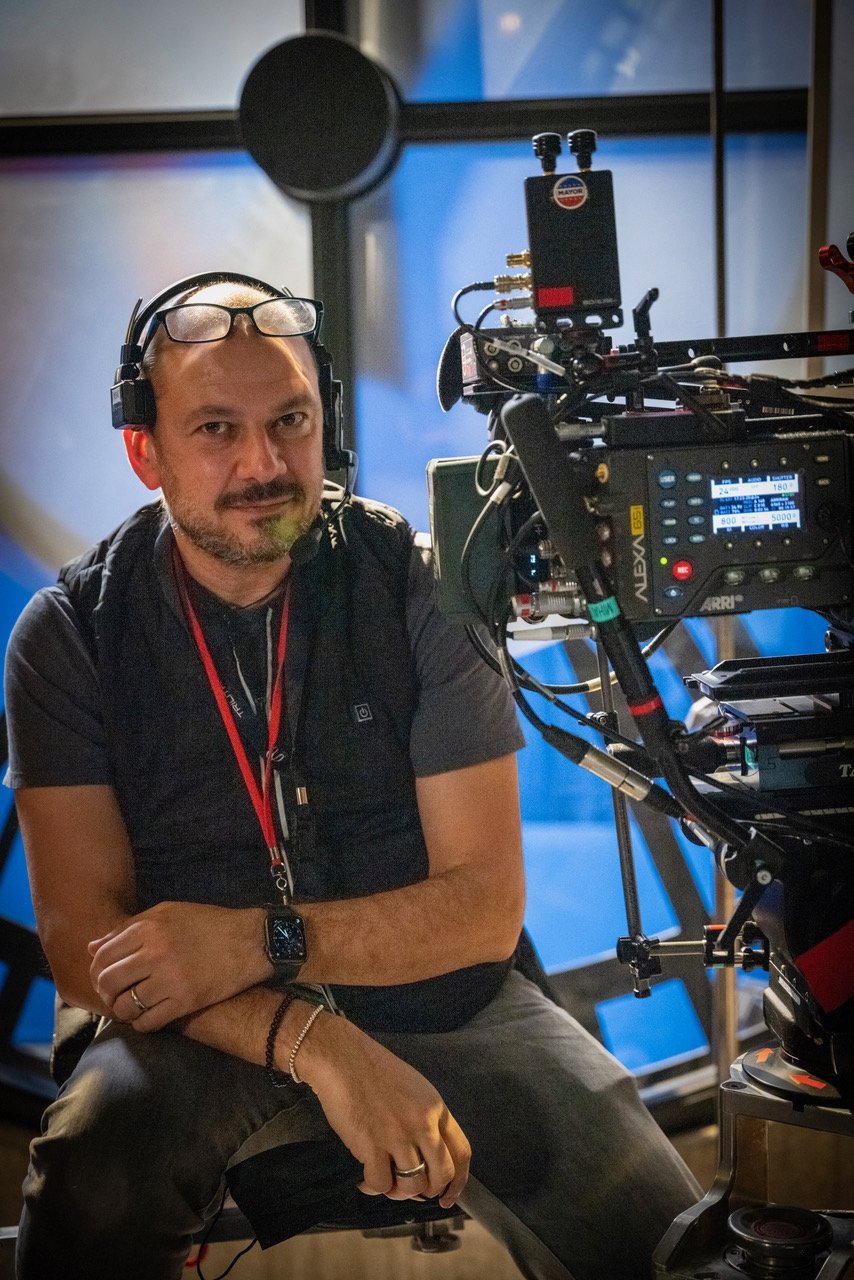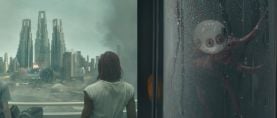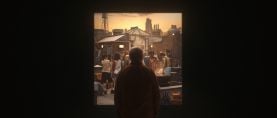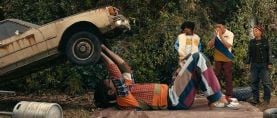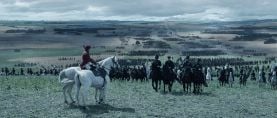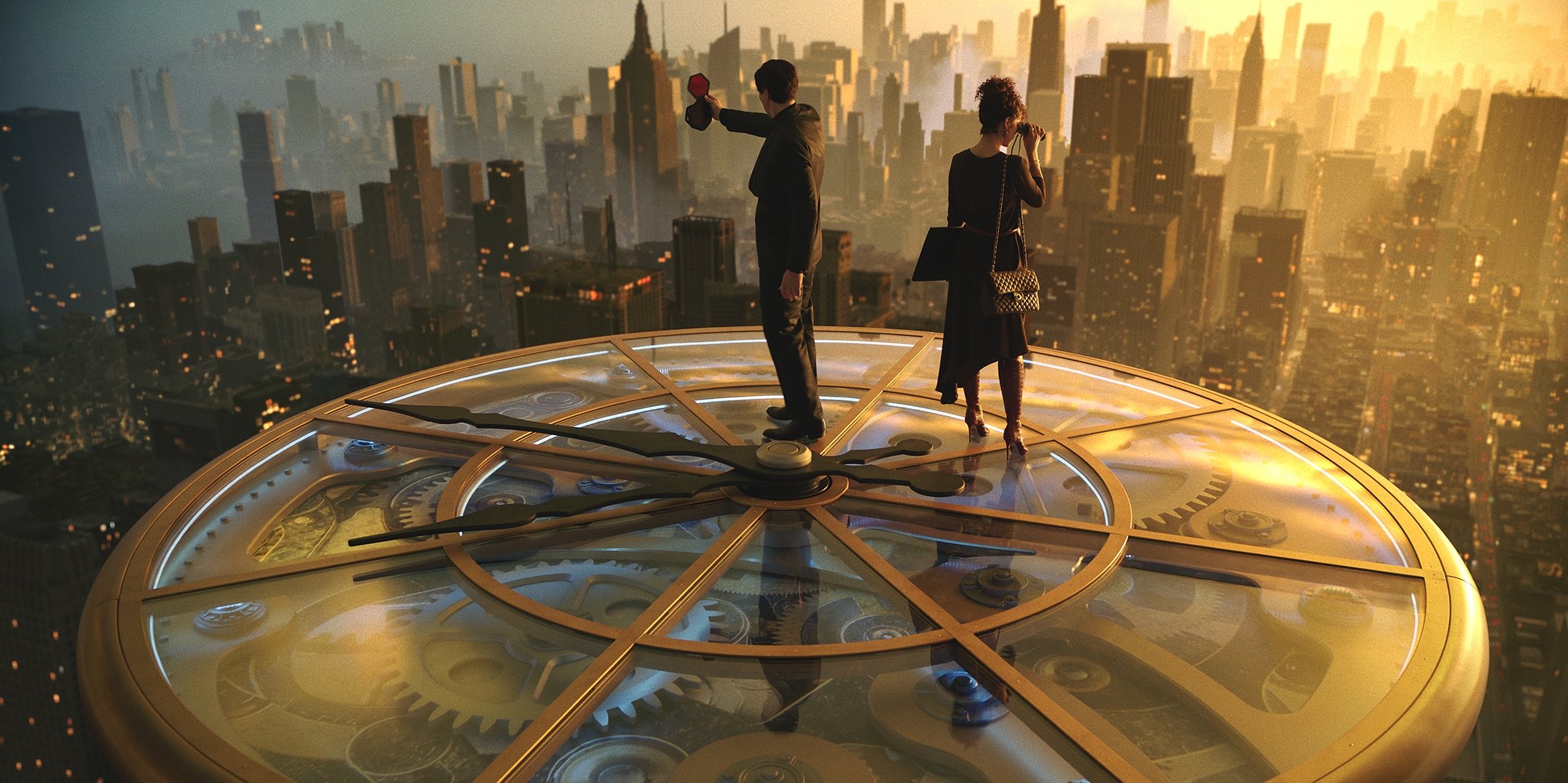
Material Ecology for Megalopolis
Mihai Mălaimare Jr., ASC and visual effects supervisor Jesse James Chisholm discuss creating Francis Ford Coppola’s provocative parable.
Unit photography by Phil Caruso. All Images courtesy of Lionsgate.
In his book on the making of Apocalypse Now, journalist Peter Cowie reported that toward the end of shooting his Vietnam odyssey, filmmaker Francis Ford Coppola was cooking up an even more ambitious production. Little was known about the project other than its title, Megalopolis, and vague descriptions that hinted at a science fiction tale of a visionary architect attempting to build a utopian city.
Reports emerged decades later of a Megalopolis table-read — including Robert De Niro, Paul Newman, Leonardo Di Caprio, Uma Thurman, and James Gandolfini — and test shoots with director/cinematographer Ron Fricke, creator of the visually spectacular documentaries including Koyaanisqatsi (1982), Chronos (1985) and Baraka [AC, Nov. 1993], employing a Sony F900 digital camera on the streets of New York City. The project folded after the September 11, 2001 terrorist attacks, which Coppola told journalists had smashed his utopian dream.
Twenty-three years later, Megalopolis appeared as a Lionsgate release of Coppola’s self-financed American Zoetrope epic. With cinematography by Mihai Mălaimare Jr., ASC, the film stars Adam Driver as architect Cesar Catilina, who resides in a penthouse studio atop the Chrysler Building where he dreams of rebuilding the city — stylized as ‘New Rome’ — battling rival industrialists and scheming politicians.
“Every time I work with Francis, I know it will be something
totally different and unexpected, and going to push boundaries.”
— Mihai Mălaimare Jr., ASC
The project’s long gestation ironically led to Mălaimare and Coppola’s first collaboration, on the maverick filmmaker’s 2007 independent feature Youth Without Youth, which Mălaimare joined as a recent graduate from Caragiale National University of Theatre and Film in Bucharest, Romania. It was shot using Sony HDW-F900 CineAlta cameras paired with the SRW1 HDSR recorder — a unique digital production solution at the time. “The reason Francis decided to start Youth Without Youth was because he couldn’t make Megalopolis,” observes Mălaimare. “When we were in prep for Youth Without Youth, I remember seeing art concepts for Megalopolis. And, as he’s done for all his life, Francis was pushing everything technology-wise — he was sure that the future would be HD. I remember seeing hours of second-unit establishing shots by Ron Fricke of New York shot while they were prepping Megalopolis, to familiarize ourselves with that technology. We watched that footage to see what the cameras could do for Youth Without Youth. Since then, in all these years, little bits of information, videos, and images have come to me. So, I got to know Francis because he couldn’t make Megalopolis at that time.”

Reunited to make the ambitious film, Mălaimare and Coppola built on their previous collaborations — the experimental features Tetro (2009) and Twixt (2011), and an ongoing documentary entitled Distant Vision — as well as influences from the minimalist camera motions of Yasujirō Ozu’s films to Golden Age Hollywood fare. “Francis wanted to move the camera a little more on Megalopolis,” Mălaimare recalls. “But he wanted to stay true to the visual style that we’d established. It was fascinating because he likes to give his actors freedom. For example, if a character is seated and all of a sudden stands, we don’t tilt up. We will position a second camera at the new height and he will use editing for that [transition]. It makes you compose so much better, going back to when everything was much more thought-out ahead of time.”
Coppola referred Mălaimare to an eclectic mix of cinematic referents. “There was a 1945 Sherlock Holmes [Universal Picture] The Woman in Green, and Neptune's Daughter [a Technicolor MGM production] from 1949. For a sequence set in Madison Square Garden, he talked about Busby Berkeley. It was a constant discussion and search for visual references.”
The filmmakers selected a grand canvas for the film using two Arri Rental Alexa 65s and an Alexa LF camera for main unit, and an Alexa Mini LF for second unit. Panavision provided lenses including Sphero 65 and Panaspeed spherical primes and a modified Primo Artiste, as well as a rehoused Russian Helios and a Lensbaby for special scenes. “I’d used the Alexa 65 for commercials and small projects,” says Mălaimare, “but this was the first time I’ve used it as a main camera. We knew early on that we wanted to concentrate on an IMAX release, and we watched all our camera tests at the IMAX headquarters in L.A. A lot of cameras will make the cut resolution-wise, but there is something about the IMAX environment which, in my mind, is synonymous with 65mm film.”
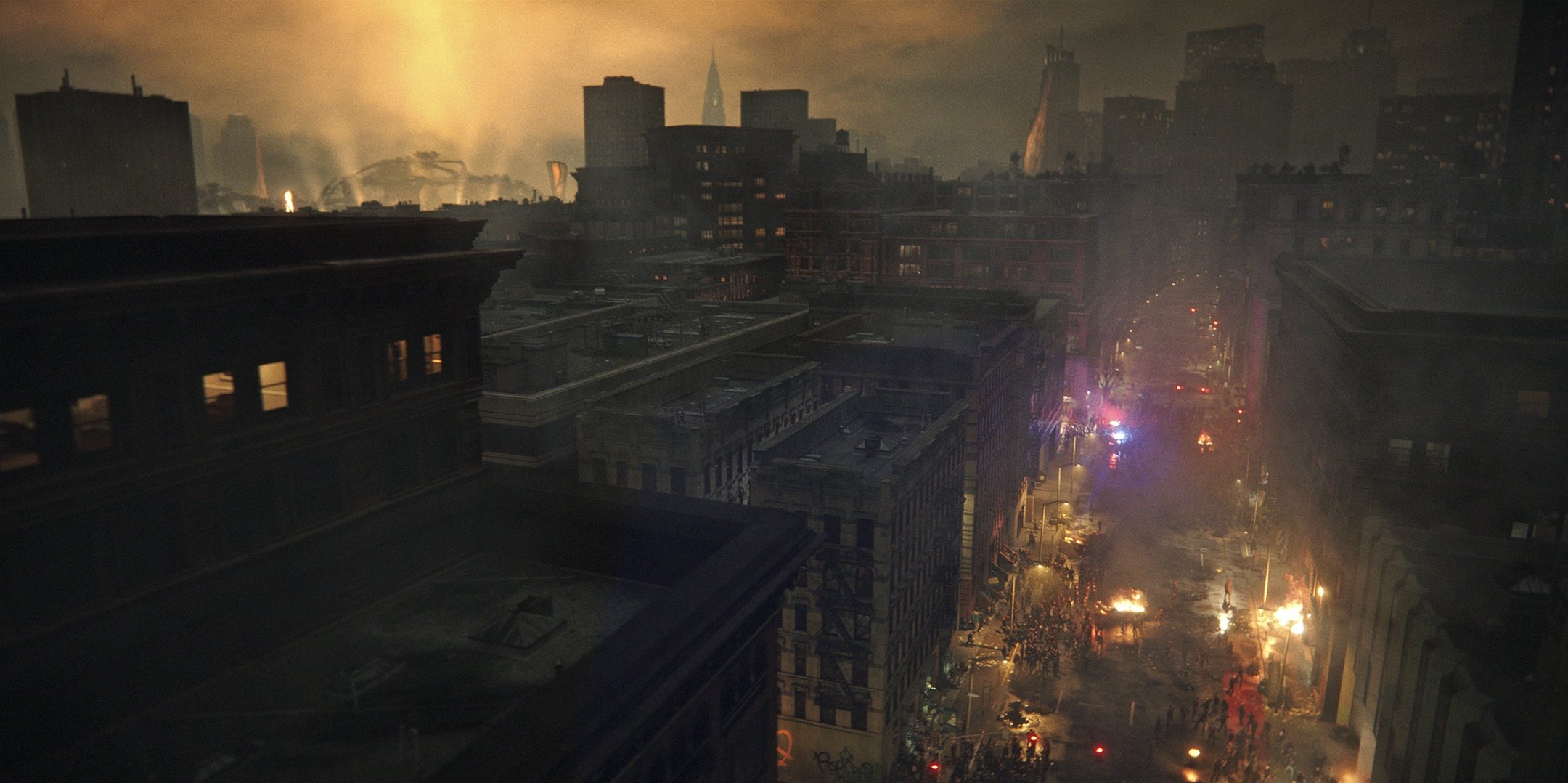
City Building
To construct Coppola’s vision of New Rome, the production established a base of operations at a disused Days Inn hotel in Peachtree City, Georgia. Shooting began in November of 2022 and included stages and locations in and around Atlanta, Georgia, including Trilith Studios and its Prysm Stage — now Lux Machina’s Lux Stage — which offered an 18,000-square-foot virtual production volume with reconfigurable LED panels. Additional plate photography included locations in Italy, New York City, Ontario, and Japan.
The production made headlines when, after a month of shooting, Hollywood trade papers splashed the news that Coppola had fired his art department and visual effects team. Coppola addressed the régime change with his inimitable panache, as the production’s sole financial guarantor, and brought on board a new team, including his son Roman Coppola, with whom he had collaborated in a similar capacity onBram Stoker’s Dracula [AC, Nov. ‘92]. Bradley Rubin joined as production designer and Jesse James Chisholm — Coppola’s nephew and veteran of Marvel productions — stepped in as visual effects supervisor during the last week of principal photography, which wrapped in March of 2023.
Coppola’s desire to capture his vision as much as possible in-camera extended to work in the LED volume, as seen in the opening of the film where Cesar teeters precariously on the summit of the Chrysler Building, contemplating the city from a vertiginous perspective. “There were so many things that we wanted to do in-camera,” notes Mălaimare. “Working closely with Roman, who was our second-unit director and cinematographer, we explored many ideas using mirrors and other tricks. The volume helped a lot. The actors could see the environment and feel clouds moving in front of the sun. It was just a matter of understanding the technology. You must be 100 percent prepared, and it is hard — not impossible — but it is time-consuming to change things on the spot. From that perspective, as much as Francis embraces new technology, it is a struggle because you have to be so precise in choosing your background. The volume is an amazing technology, as long as you understand it won’t solve all your problems.”
“My instinct was to replace everything,
to create photo-immaculate images.
But I ended up realizing that was not my job.”
— visual effects supervisor Jesse James Chisholm
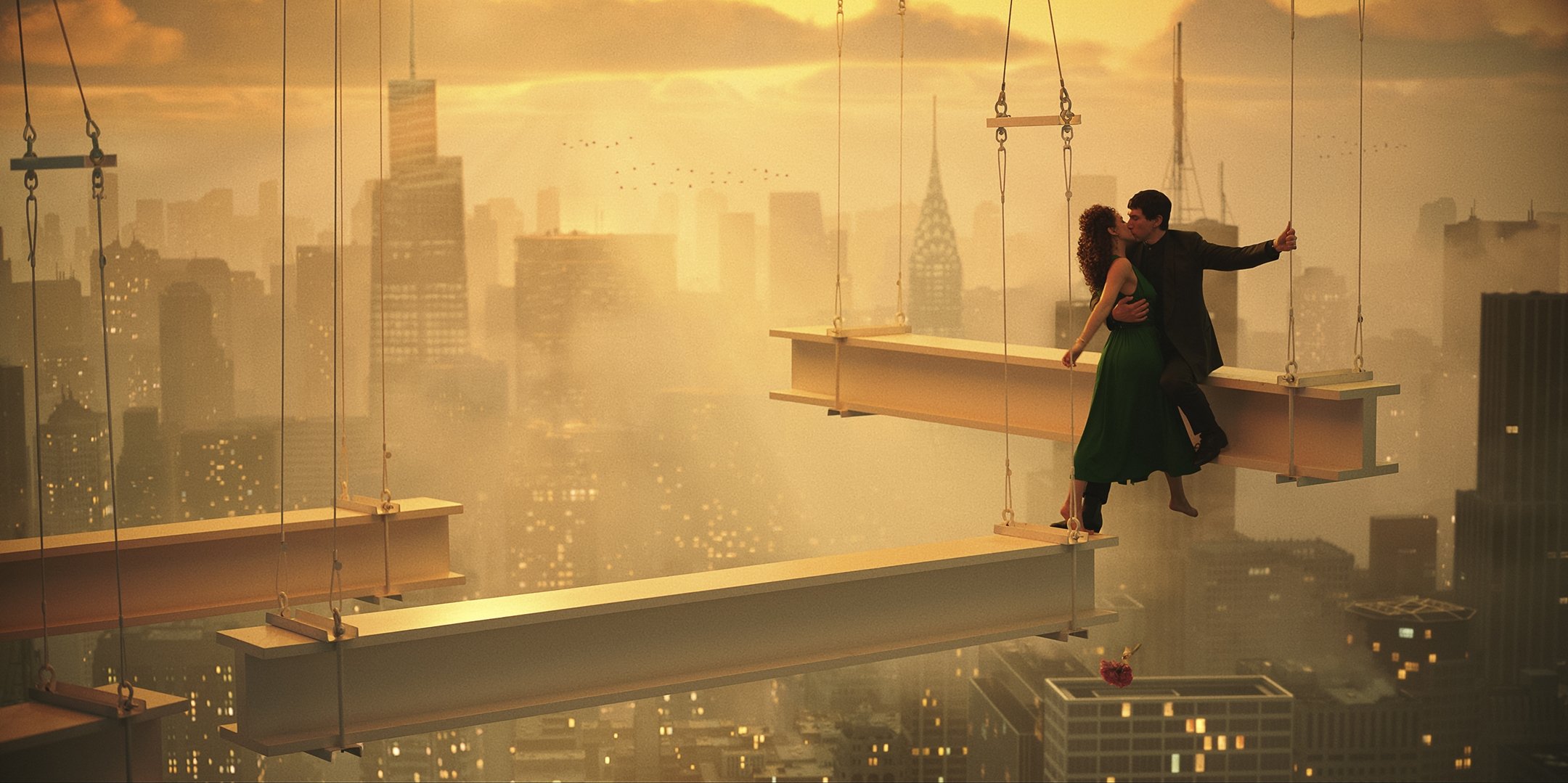
Work in the volume allowed Coppola to capture images atop the Chrysler Building in extended twilight and sunset scenes, where time appeared to stand still around Cesar and his lover, Julia Cicero (Nathalie Emmanuel). RISE Visual Effects digitally removed wire rigs and added details to cityscapes. “I learned so much coming onto this film,” says Chisholm. “My instinct was to replace everything, to create photo-immaculate images. But I ended up realizing that was not my job. My role was to give Francis exactly what he wanted. That was my education on this film. We did a lot of cleanup on those scenes. We added blinking lights, some extensions, and changed densities. But we left the footage mostly intact because it had poetic realism.”
In later scenes, where Caesar and Julia step out onto I-beams suspended from cranes, performers were suspended high above the studio floor. “You could feel it in Nathalie’s performance,” adds Chisholm. “She was a little scared of walking out to meet with Adam. Francis talked about when you have that first kiss, it feels like you’re 8,000 feet high on a girder and the danger that comes with it. That scene always had a special place for me. It felt like a Translight [backing], but it worked. Oliver Schulz was our supervisor at RISE on those scenes. They painted out safety cables and added birds and clouds. And then, on a reverse angle, RISE built out the scene, because that wasn’t there.”
Lux Machina recently released this video detailing some of virtual stage work done for the film:
Chisholm and his team addressed Coppola’s needs during postproduction, and brought on board five visual effects studios — RISE, Ghost VFX, Narwhal Studios, Wild Capture and Universal Production Partners (UPP) — with previsualization work done at Digital Domain and The Third Floor. “I was like a gnat coming at Francis with questions and trying to get into his head,” Chisholm relates. “He hired [visual concept designer] Dean Sherriff to create concepts through post. We’d take frames that Mihai had shot, Dean would draw on them, and I worked closely with him to execute Francis’s vision. Oliver Schulz and his team at RISE were our primary vendor. It was slow going at first, because of our budget and team size. We had to tackle one issue at a time, and it was not possible to do a lot of iterating because we had other tasks down the road. Ollie met with Francis, and he really got it. We were able to do the bulk of our work in Germany, using tax incentives with the help of the German government.”
When Coppola tightened his postproduction budget, the VFX team committed to deliver a month early. Chisholm reigned in the work by assembling an in-house VFX team — compositing supervisor Peter Herlein, compositor Jonas Bruse, VFX coordinator Konrad Wilbrandt, and senior virtual production supervisor Johnson Thomasson who worked in Unreal Engine game-engine renderer. “That allowed Francis to look at shots in real-time,” says Chisholm. “We were on RISE’s network at the hotel for our in-house team, and so we were able to make changes for Francis in real time. We wouldn’t have been able to deliver the film without that. We kept it small and scrappy. Christopher Finley was our visual effects associate producer. I had one other coordinator, Elliot Goff, and then VFX editor Stephen Fletcher was doing so much that he became a picture editor on the show, which left Adam Fickle as my assistant VFX editor. Except for three of those guys, we lived at the hotel in Peachtree and we completely dedicated ourselves to this process. Francis called it his ‘cruise ship,’ and we were all there making this film.”
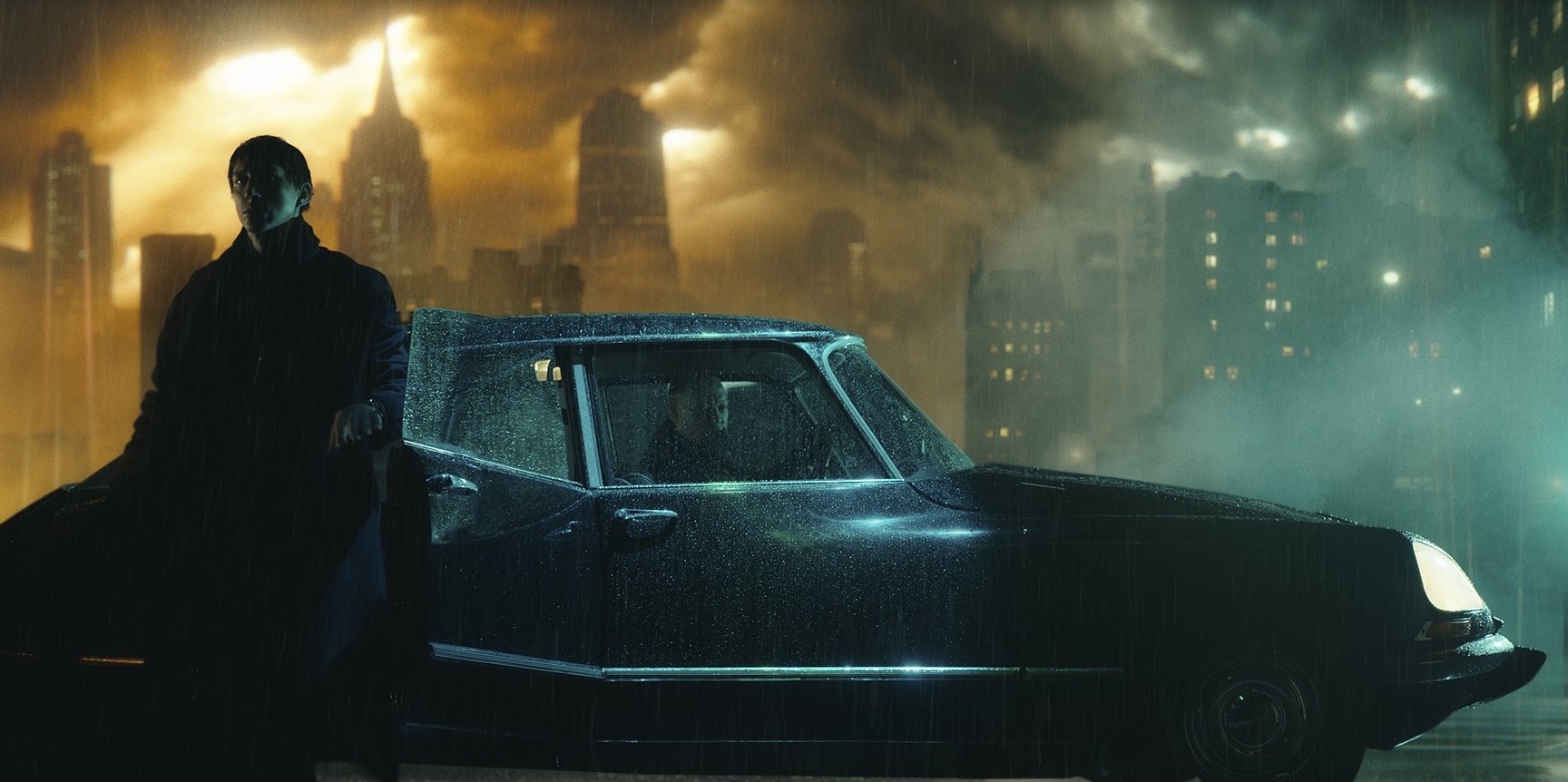
Visual effects and in-camera effects combined for one of the film’s most poetic interludes where Cesar ventures out on a night drive into New Rome’s slums and his vehicle passes giant effigies of broken statuary that come to life. Coppola staged car interiors as a two-day ‘poor man's process’ at Trilith Studios. “On stage, we had just a few moving lights and a little bit of rain,” says Mălaimare. “That evolved to include moving set pieces, miniature cars, and statues.” For slum exteriors, Roman Coppola and miniatures cinematographer Christopher Warren staged a second-unit shoot using statue performers in prosthetics, 1/4-scale miniatures, and painted backdrops. “That was an idea that evolved after we shot our main actors, second unit took over and it was brilliant work. The statues were real humans with makeup on them, which led to finding the dimension of the miniature car.”
Dean Sherriff provided concept art for the night drive where Cesar pauses at a mysterious flower stall. RISE enhanced the stage photography with a stylized matte painting depicting the florist as an oasis of light and for the exterior of a townhouse where Cesar lays flowers in tribute to his deceased wife.
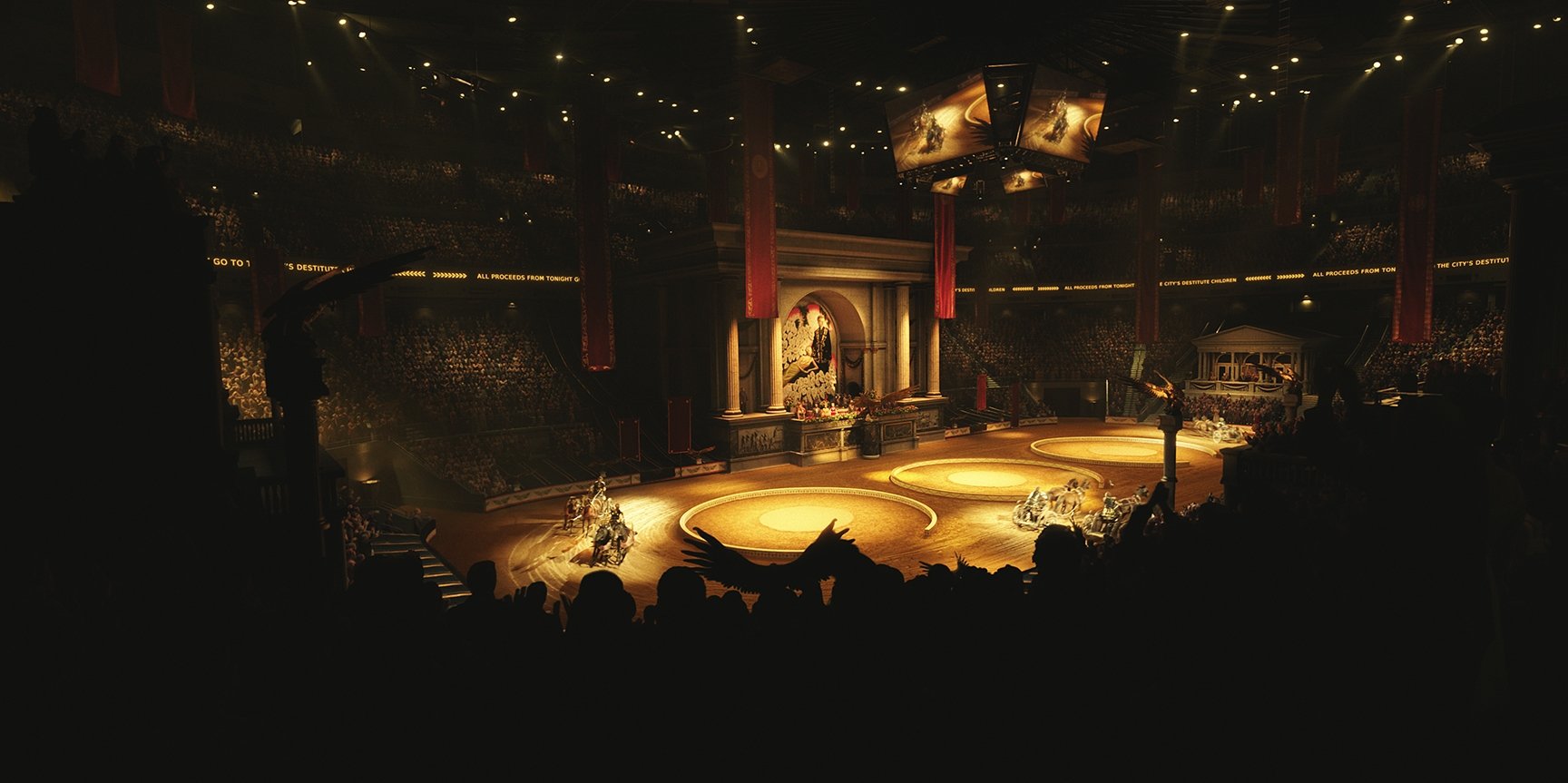
The Circus
A centerpiece sequence involves Cesar attending a celebration at Madison Square Garden, where industrialist Hamilton Crassus III (Jon Voigt) presides over Ben-Hur-style chariot racing and a wire-flown dance extravaganza in the three-ring circus. The filmmakers staged the sequence inside Gas South Arena in Duluth, where two chariots raced on a red-dirt race track. Visual effects added to the spectacle, adding to the crowd and the cavernous architecture. “The footage was impressive and daunting,” comments Jesse James Chisholm. “You could see the scope that Francis wanted, and I knew that we were going to have to have to replace a lot of the environment. Dean Sherriff worked up stills to show the size of the stadium and the crowd.”
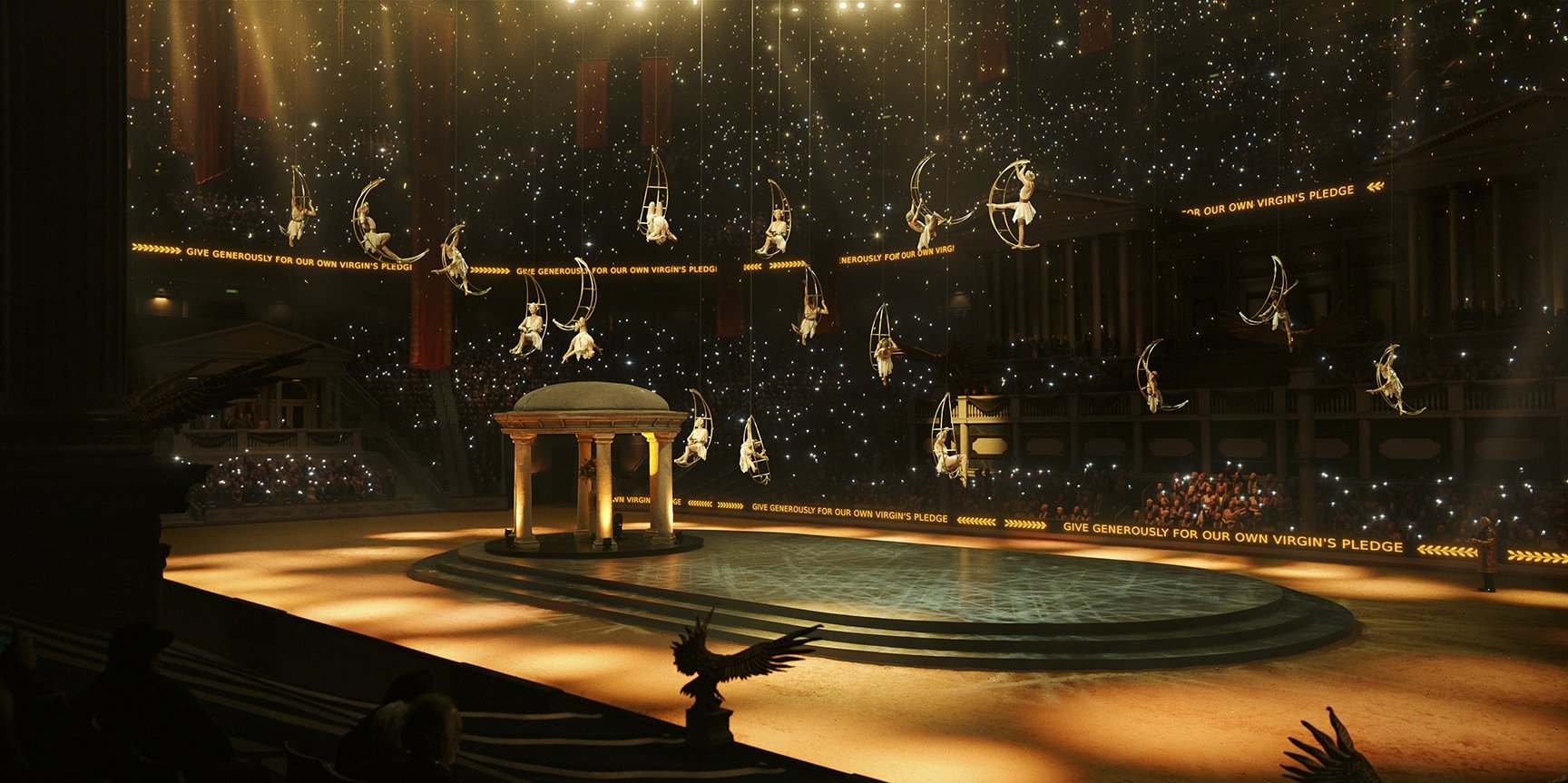
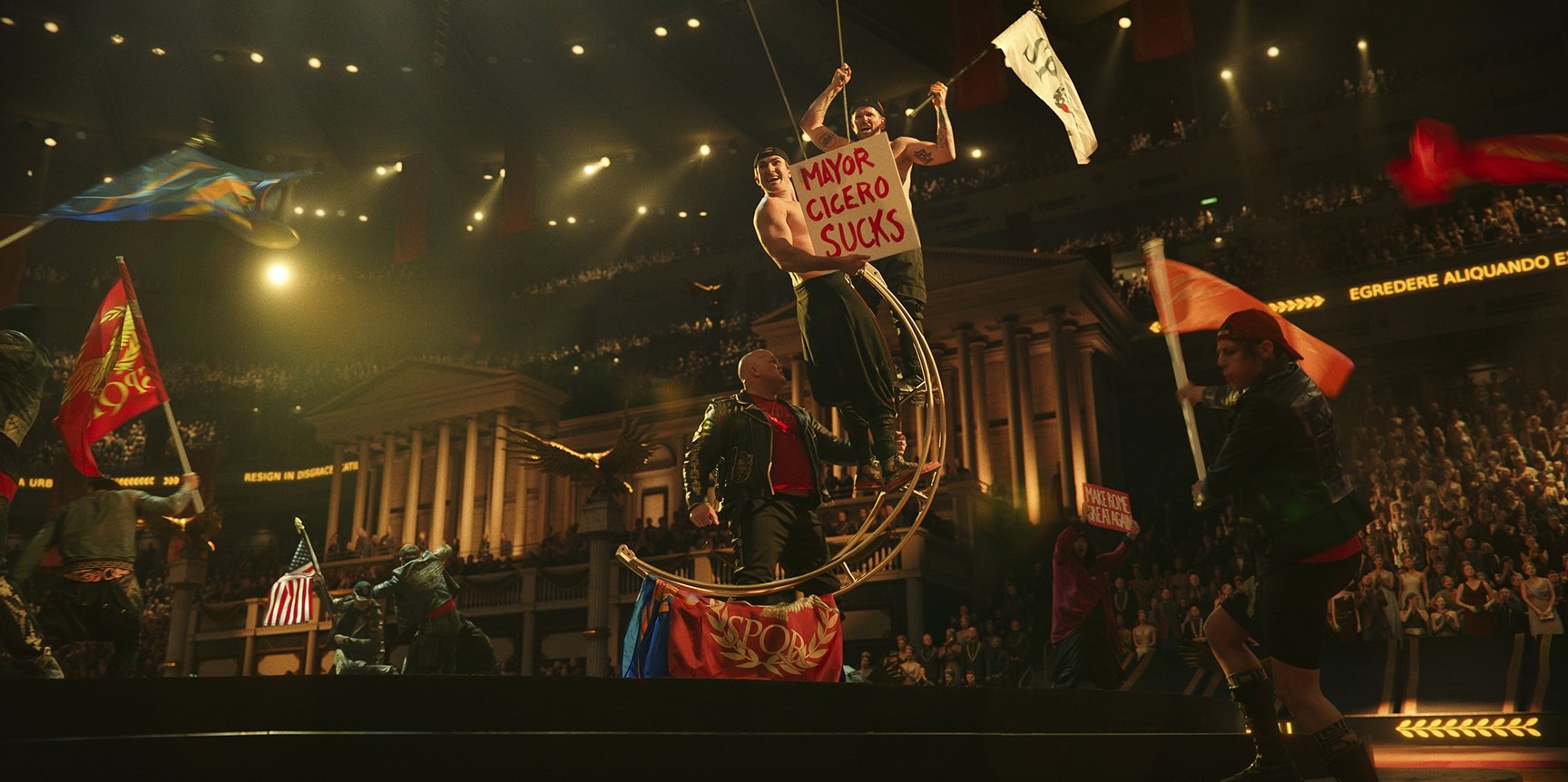
Enhancements include a detail that Coppola recalled from childhood visits to the MSG venue in Midtown Manhattan. “When he was young, Francis told me he would look up into the rafters and see all the props that we’re going to be used later in the show. As an ode to that, we added a plane suspended behind the acrobats and other details. Every image means something to Francis.”
To gather crowd assets, the production engaged Wild Capture digital human capture specialists in Los Angeles and Creative Media Industries at Georgia State University in Atlanta where Coppola, wardrobe designer Milena Canonero, and Chisholm conducted a three-day capture session for stadium crowd and other street scenes. RISE expanded stadium interiors and added spectators with varieties of motion, referencing production plates of on-set performers.
Star of the stadium show, Vesta Sweetwater (Grace Wanderwaal) appears in a gown made from fabric that appears to bend light, rendering its wearer partially see-through. Underwaal wore a dress of highly reflective 3M material. Roman Coppola then staged Vesta gown scenes as ‘Pepper’s Ghost’ beam-splitter illusion, using light projections aimed at the dress reflected off a half-silvered mirror aligned to the axis of the camera.
“The dress material had a high co-efficiency of reflectiveness,” explains Mălaimare. “We used that with a two-way mirror to project along the line of view with the camera, projection mapping. We shot the background first, projected that on top of the dress, and that was reflected, so the dress looked transparent. The first day, Roman prepped the effect, it was amazing for everyone on set.”
Ghost VFX supervisor Kevin Chandoo and his team then enhanced Vesta’s entry and added energy effects and graphic treatments that appeared to flow with the fabric.
The stadium sequence climaxes in a psychedelic montage of time-bending imagery depicting Cesar’s descent into drug-and-alcohol-infused madness. Coppola and editor Cam McLaughlin built montages from improvisational performances, elements of stock footage, reshoots, and visual effects that Stephen Fletcher assembled for multi-element composites. “We built the montages until they became more realized to what Francis had in mind,” relates Chisholm. “Peter Herlein then figured out how to how to create a 17,000-frame composite in Nuke, which was daunting with so many pieces, followed by another 11,000-frame shot, making sure every transition led to the next story beat to grab the audience, and for Francis to emotionally connect. It was like painting with the abstract.”
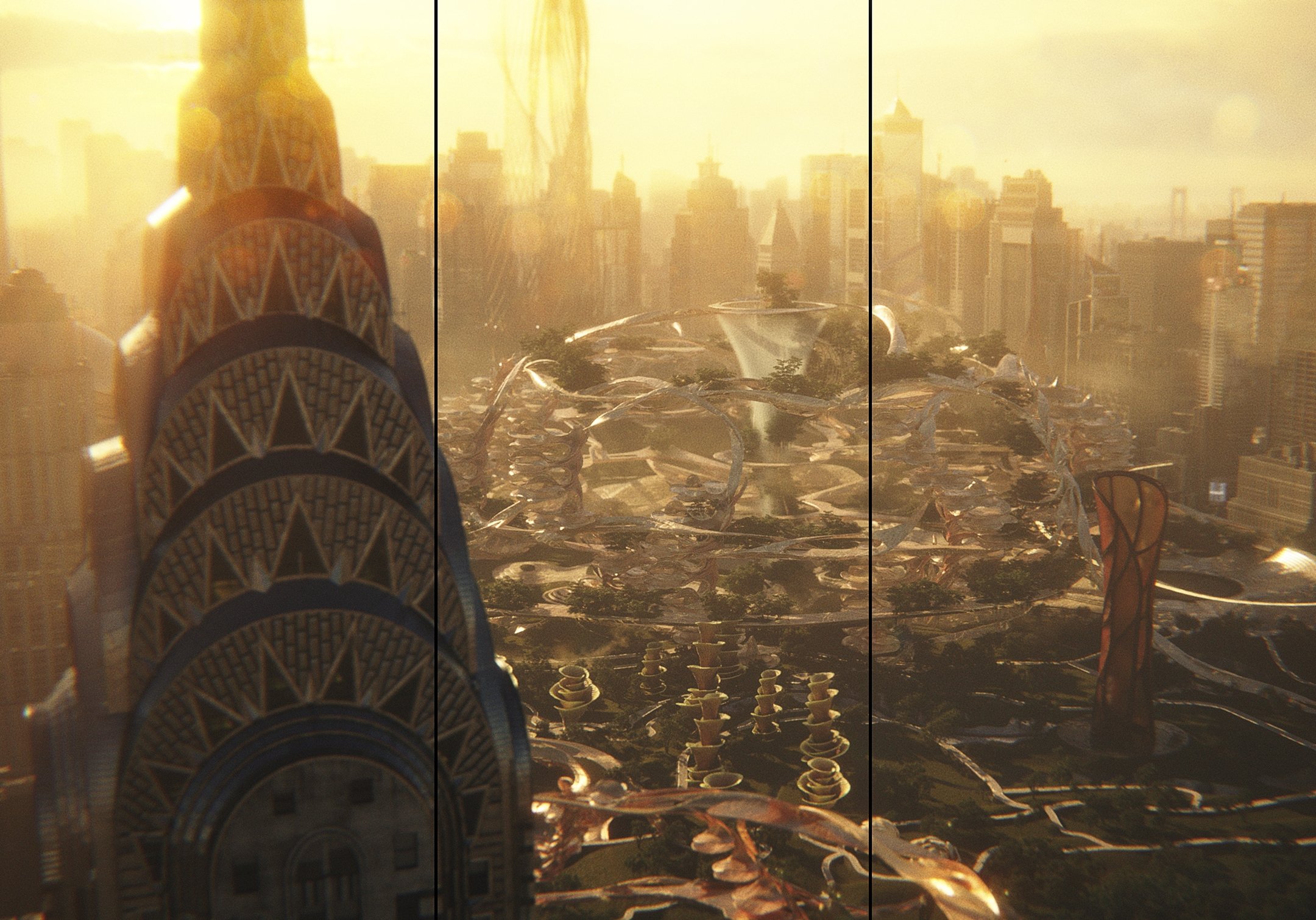
Megalon
Cesar’s master plan to revitalize New Rome with architecture built from a self-regenerating material, known as Megalon, takes shape as a glowing golden structure in Central Park. Dean Sherriff produced keyframe concept art based on the designs of Israeli-American designer Neri Oxman, who coined Cesar’s descriptive phrase “Material Ecology.” Sherriff’s concept influenced a golden color palette, as seen in a dinner party scene with characters seated inside a luminous, undulating Megalon interior. “That was a difficult scene to figure out,” recalls Mălaimare. “We did that with moving fabrics. We had light shooting in certain spots, so as the fabric opened, it let in a little more or a little less light. Francis wanted it to feel like we were inside a flower.”
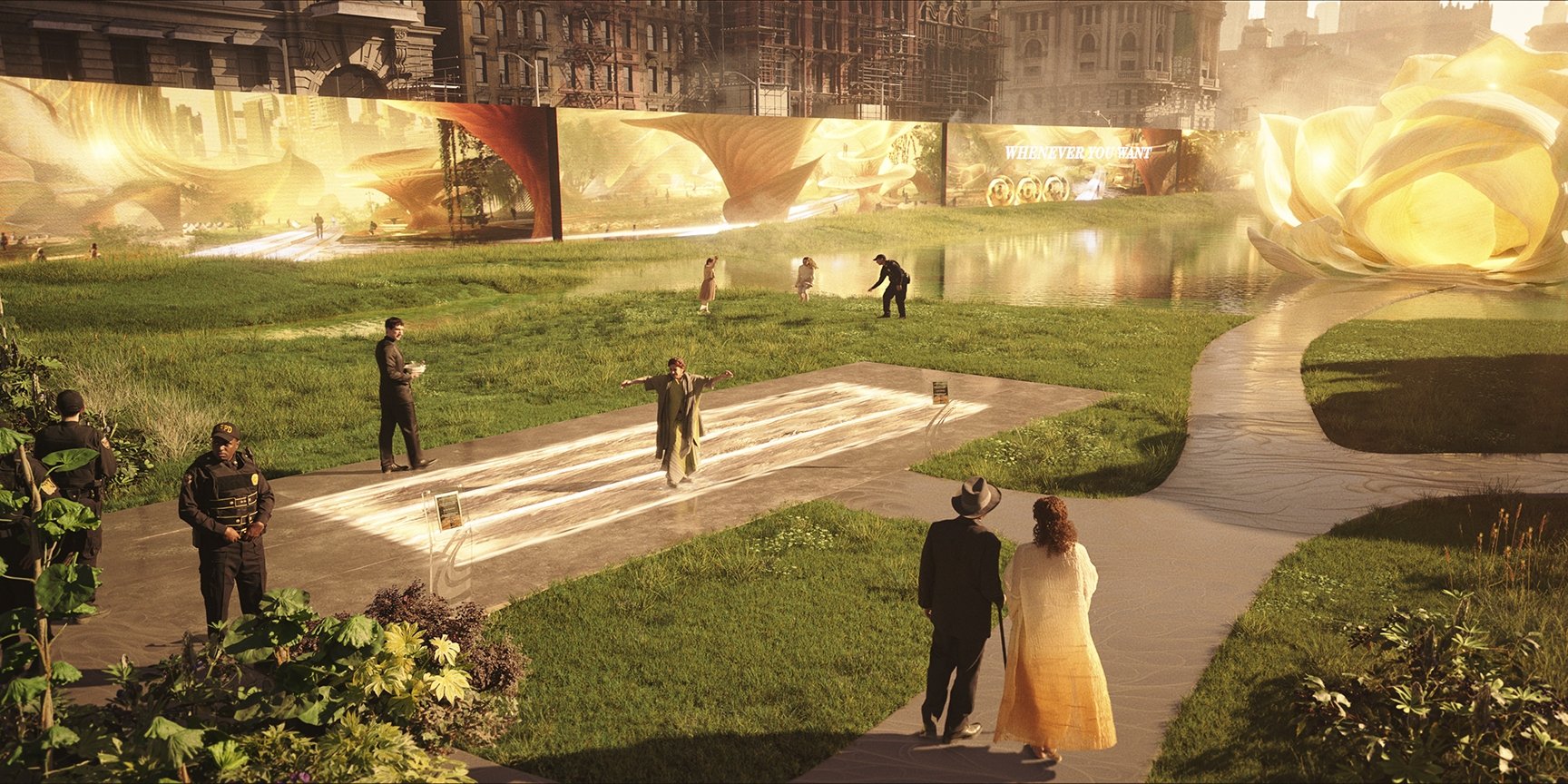
At the climax of the film, Cesar receives a gunshot wound to his face during an assassination attempt, which he heals with Megalon, causing his flesh to heal in a golden fusion with his skull. Adam Driver performed Megalon face scenes wearing a prosthetic, which Roman Coppola enhanced on-set using beam-splitter projections of textures created by concept artist Till Nowak. “We wanted it to feel like an organic material that was constantly moving and reflecting light,” says Mălaimare. “In the end, that needed VFX help, but it gave us a real element for Jesse to work on.”
Coppola referred the VFX team to John P. Fulton, ASC’s optical effects on Claude Rains in The Invisible Man
(1933). “We wanted the Megalon to feel subcutaneous on Caesar’s face,” explains Jesse James Chisholm. “Dean created a concept of what that would look like. And then Ollie and his team at RISE did a first round. That still felt too ‘surfacey,’ and needed to feel more like a living, breathing thing. And so, they went and added spans of ventricles fading into the nose until it felt alive and growing into Cesar’s face.”
After more than four decades in development, followed by a 79-day shoot, Megalopolis emerged as a benchmark for its filmmaking family. “The only thing that I’m afraid of,” says Mălaimare, “is to be put in a box, doing the same project over and over again. I’m always looking forward to things that I've never done. Every time I work with Francis, I know it will be something totally different and unexpected, and going to push boundaries.”
“Francis exhausted every option to crack this code and try to figure this film out,” adds Jesse James Chisholm. “Our process was to work all week, and by Friday night or Saturday midday, we’d all get together, watch the film, and talk about it. Every week, I was giddy. Knowing that I was part of that process, I couldn’t wait to see what was coming out of his head. One time, I was seated behind our editor, Cam, as he was auditioning two cuts of a scene for the end of the movie with two different rhythms. Francis was to my right, and I started to get weepy. It hit me: after all these years, I’m the guy who gets to create this world with Francis Ford Coppola. I got super emotional. Francis tapped me on the shoulder and said, ‘Jesse, I think the best way to announce that I’m done with this film is to announce that, one year from now, I’ll be shooting another film in London.’ Francis is amazing. He has so much energy. I’m 50; he’s 84, and he will outwork me. He’s far from done.”
You'll find our interview with Francis Ford Coppola about the film here.
Mălaimare is also known for his camerawork in such features as The Master, A Walk Among the Tombstones, Jojo Rabbit, The Hate U Give and The Harder They Fall.
He was invited to join the ASC in 2023.
